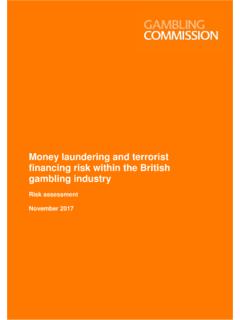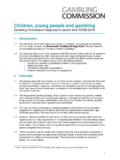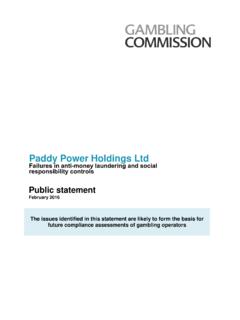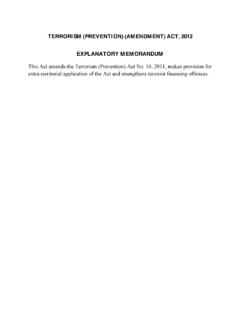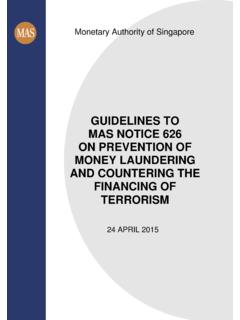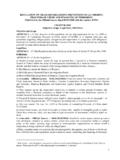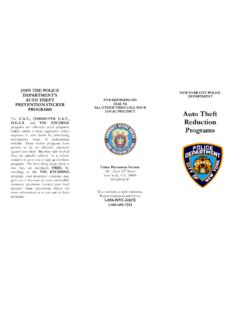Transcription of The prevention of money laundering and …
1 The prevention of money laundering and combating the financing of terrorism Guidance for remote and non-remote casinos Fourth edition March 2018. October 2017. Contents 1 Introduction 6. What is meant by the proceeds of crime and money laundering ? 6. Legal background 7. The role of gambling operators 10. The role of the Gambling Commission 11. Purpose of the guidance 12. How should the guidance be used? 13. Content of the guidance 13. Status of the guidance 14. Licence conditions and codes of practice 14. 2 Risk-based approach 15. Introduction 15. Identifying and assessing the risks 16. Risk assessments 17. Risk management is dynamic 22. 3 Customer relationships 23. Establishment of business relationship 24. Customer monitoring 25. Termination of business relationship 25. 2. 4 Senior management responsibility 26.
2 Introduction 26. Obligations on all casino operators 26. Policies, procedures and controls 27. Internal controls 28. Training 29. 5 Nominated officer 32. Standing of the nominated officer 32. Internal and external reports 33. 6 Customer due diligence 34. Introduction 34. Customer due diligence measures 35. Timing of verification 36. Ongoing monitoring 37. Enhanced customer due diligence and enhanced ongoing monitoring 37. Threshold approach 39. Identification and verification on entry 41. Identification and verification 41. Electronic verification 42. Criteria for use of an electronic verification provider 43. Documentary evidence 44. Politically exposed persons (PEPs) 46. Simplified customer due diligence 49. Reliance 50. Requirements to cease transactions or terminate relationship 51. List of persons subject to financial sanctions 52.
3 3. 7 Record keeping 53. General legal and regulatory requirements 53. Business relationships 54. Other casino customers 55. Customer information 55. Supporting records (non-remote casinos) 55. Supporting records (remote casinos) 56. Supporting records (gaming machines) 56. Retention period 57. Form in which records are to be kept 57. Data protection 58. 8 Suspicious activities and reporting 58. Introduction 58. What is meant by knowledge and suspicion? 59. What is meant by reasonable grounds to know or suspect? 60. What constitutes suspicious activity? 60. Internal reporting 61. Evaluation and determination by the nominated officer 61. External reporting 62. Submission of suspicious activity reports 62. Requesting a defence 64. Applying for a defence 68. Suspicious activity reporting requirements for remote casinos 68.
4 Failing to report 69. After a report has been made 70. Tipping off, or prejudicing an investigation 70. 4. Figures Figure 1: Risk-based approach 74. Figure 2: Customer due diligence 75. Figure 3: Determining when the threshold is reached (non-remote casinos) tokens and gaming machines 76. Figure 4: Determining when the threshold is reached (non-remote casinos) casino account 77. Figure 5: Determining when the threshold is reached (remote casinos) 78. Figure 6: Record keeping 79. Figure 7: Reasonable grounds to suspect (objective test) 80. Figure 8: Knowledge or suspicion of money laundering or terrorist financing (subjective test) 81. Figure 9: Defence under POCA or terrorism Act 82. Figure 10: Suspicious activity reporting requirements for remote casinos 83. Annex A Glossary of terms 84.
5 Appendix FG17/6 The treatment of politically exposed persons for anti- money laundering purposes 5. 1 Introduction The law concerning money laundering is based on the general and wide ranging prevention and detection of the use of any proceeds of crime, and the prevention and detection of terrorist financing . For some businesses (including casinos) this includes the more specific requirements of the business and its employees to have policies, procedures and controls in place covering the risks they face from money laundering and terrorist financing . Using money in casinos, regardless of the amount, that is the proceeds of any crime can amount to money laundering if the person using or taking the money knows or suspects that it is the proceeds of crime. money laundering offences can be committed by both the customer and casino employees, depending on their respective levels of knowledge or suspicion.
6 What is meant by the proceeds of crime and money laundering ? Broadly, the term 'proceeds of crime' or 'criminal proceeds' refers to all property from which a person benefits directly or indirectly, by being party to criminal conduct, for example, money from drug dealing or stolen in a burglary or robbery (this is commonly referred to as criminal property). It also includes property that a person gains by spending the proceeds of criminal conduct, for example, if a person uses money earned from drug dealing to buy a car or a house, or spends money gained in a bank robbery to gamble. money laundering is a term that is often misunderstood. It is defined in section 340 of the Proceeds of Crime Act 2002 (POCA) and covers wide ranging circumstances involving any activity concerning the proceeds of any crime.
7 By way of example, this may include: trying to turn money raised through criminal activity into clean' money (that is, classic money laundering ). possessing or transferring the benefit of acquisitive crimes such as theft and fraud, and funds generated from crimes like tax evasion (this includes the possession by an offender of the proceeds of his own criminal activity). possessing or transferring stolen goods being directly involved with any criminal or terrorist property, or entering into arrangements to facilitate the laundering of criminal or terrorist property criminals investing the proceeds of their crimes in the whole range of financial products. Typically, classic money laundering consists of a number of stages: placement layering integration. Placement is the first stage in the money laundering cycle.
8 The laundering of criminal proceeds is often required because of the cash-intensive nature of the underlying crime (for example, drug dealing where payments take the form of cash, often in small denominations). The monies are placed into the financial system or retail market, or are smuggled to another country. The aim of the money launderer is to avoid detection by the authorities and to then transform the criminal proceeds into other assets. Layering is the next stage and is an attempt to conceal or disguise the source and ownership of the criminal proceeds by creating complex layers of financial transactions which obscure the audit trail and provide anonymity. The purpose of layering is to disassociate the criminal proceeds from the criminal activity which generated them. Typically, layers are created by moving monies in and out of various accounts and using electronic fund transfers.
9 6. Integration is the final stage in the process. It involves integrating the criminal proceeds into the legitimate economic and financial system, and assimilating it with other assets in the system. Integration of the 'clean' money into the economy is accomplished by the money launderer making it appear to have been legally earned or obtained. There is potential for the money launderer to use gambling at every stage of the process. The land-based gambling industry is particularly vulnerable during the placement stage as the use of cash is prevalent and the provenance of such cash is not always easy to determine. Although the remote gambling industry might appear less vulnerable as electronic transfers are required for placements, identity theft and identity fraud can enable the money launderer to move criminal proceeds with anonymity.
10 Furthermore, the use of multiple internet transactions can facilitate the layering stage of money laundering . Casino operators should be mindful that the offence of money laundering also includes simple criminal spend (the use of criminal proceeds to fund gambling as a leisure activity), and may not include all the typical stages of the laundering process (if any at all). Legal background The FATF Recommendations and EU Directive The Financial Action Task Force (FATF) is the inter-governmental body responsible for setting the international standards for anti- money laundering (AML) and countering terrorist financing (CTF). They issue recommendations which member countries should implement in order to combat money laundering and terrorist financing . These recommendations are implemented by over 190 countries.




